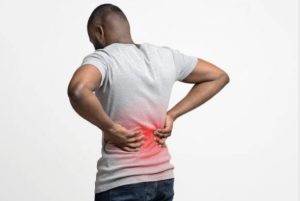Torn Disc
A torn disc occurs in the annular tissue, which is the outermost layer of the spinal disc. When this occurs, the center of a spinal disc ruptures the exterior casing, causing irritation around the soft tissue. In some cases, a torn disc may go unnoticed, but if the tear is severe, it could apply pressure to nerves, leading to neurological symptoms.
A spinal disc tear can be difficult to diagnose because the symptoms it causes can be similar to other conditions. It is also possible to be diagnosed with a torn disc even if you aren’t experiencing symptoms. Both of these situations occur because the symptoms related to a torn disc, also called an annular tear, are usually caused by nerve compression.
Causes
Torn discs can develop for a number of reasons. In most cases, natural age-related degeneration is to blame, as it dries out the bones, making them brittle. When this happens, the bones rub together which can lead to pain and discomfort. Aside from aging, there are other reasons why a torn disc may develop including:
- Strains
- Injury
- High impact activities
- Poor posture
Treatment
After arriving at a diagnosis, the doctor will encourage you to begin testing conservative treatment options. Oftentimes, this will include pain relief medicines, therapies, and other simple methods. However, if a patient tries these conservative methods and doesn’t feel any relief after a few months, they may be a candidate for surgery.
BEST Health System’s experienced doctors specialize in noninvasive procedures and are dedicated to finding you the least invasive treatment option with the best results. If you are interested in learning more about BEST Health System’s range of surgical procedures, reach out to our team today and get started on your path to recovery.
Symptoms
Some patients with a torn disc may be asymptomatic, but this condition often causes debilitating pain and can keep you from participating in your favorite activities.
Some symptoms commonly associated with a torn disc are:
- Numbness or tingling
- Muscle weakness
- Pins and needles
- Lower back pain
Diagnosis
Should you begin to experience discomfort that you believe might be related to a disc tear, the first person to see is your primary care physician. Many cases of neck and back pain are caused by a muscle strain or ligament sprain, both of which will heal over time. However, if the pain lasts longer than a few days or weeks, and is accompanied by symptoms of tingling or numbness, it is more likely to be caused by a spine condition like a torn disc.
A doctor will typically follow these steps when diagnosing back pain:
- Review of symptoms
- Physical examination
- Neurological examination
- X-ray
- Additional imaging tests
BEST Health System
If you have experienced any of these symptoms or recieved a diagnosis and need treatment, BEST can help. Take the first step towards relief today.
Some Title
Lorem ipsum dolor sit amet, consectetur adipiscing elit, sed do eiusmod tempor incididunt ut labore et dolore magna aliqua. Ut enim ad minim veniam, quis nostrud exercitation ullamco laboris nisi ut aliquip ex ea commodo consequat. Duis aute irure dolor in reprehenderit in voluptate velit esse cillum dolore eu fugiat nulla pariatur. Excepteur sint occaecat cupidatat non proident, sunt in culpa qui officia deserunt mollit anim id est laborum.
Some Title
Lorem ipsum dolor sit amet, consectetur adipiscing elit, sed do eiusmod tempor incididunt ut labore et dolore magna aliqua. Ut enim ad minim veniam, quis nostrud exercitation ullamco laboris nisi ut aliquip ex ea commodo consequat. Duis aute irure dolor in reprehenderit in voluptate velit esse cillum dolore eu fugiat nulla pariatur. Excepteur sint occaecat cupidatat non proident, sunt in culpa qui officia deserunt mollit anim id est laborum.
Related Articles
What is a Torn Disc?
Living with a Torn Disc If you or a loved one has a torn disc, also referred to as a ruptured or herniated disc, you’re […]
Living with a Torn Disc
Living with a Torn Disc If you or a loved one is experiencing torn disc symptoms, you are aware of how painful they can be. […]
Torn Disc - An Overview
What is a Torn Disc Torn discs are also known as ruptured, herniated, or slipped disc. A torn disc is a spine condition in which […]
What is Spondylolisthesis? Understanding Causes and Treatment
Spondylolisthesis comes from the Greek terms for “spine” and “slipping,” so it literally means spinal slipping. It can be a fairly common cause of spinal […]



